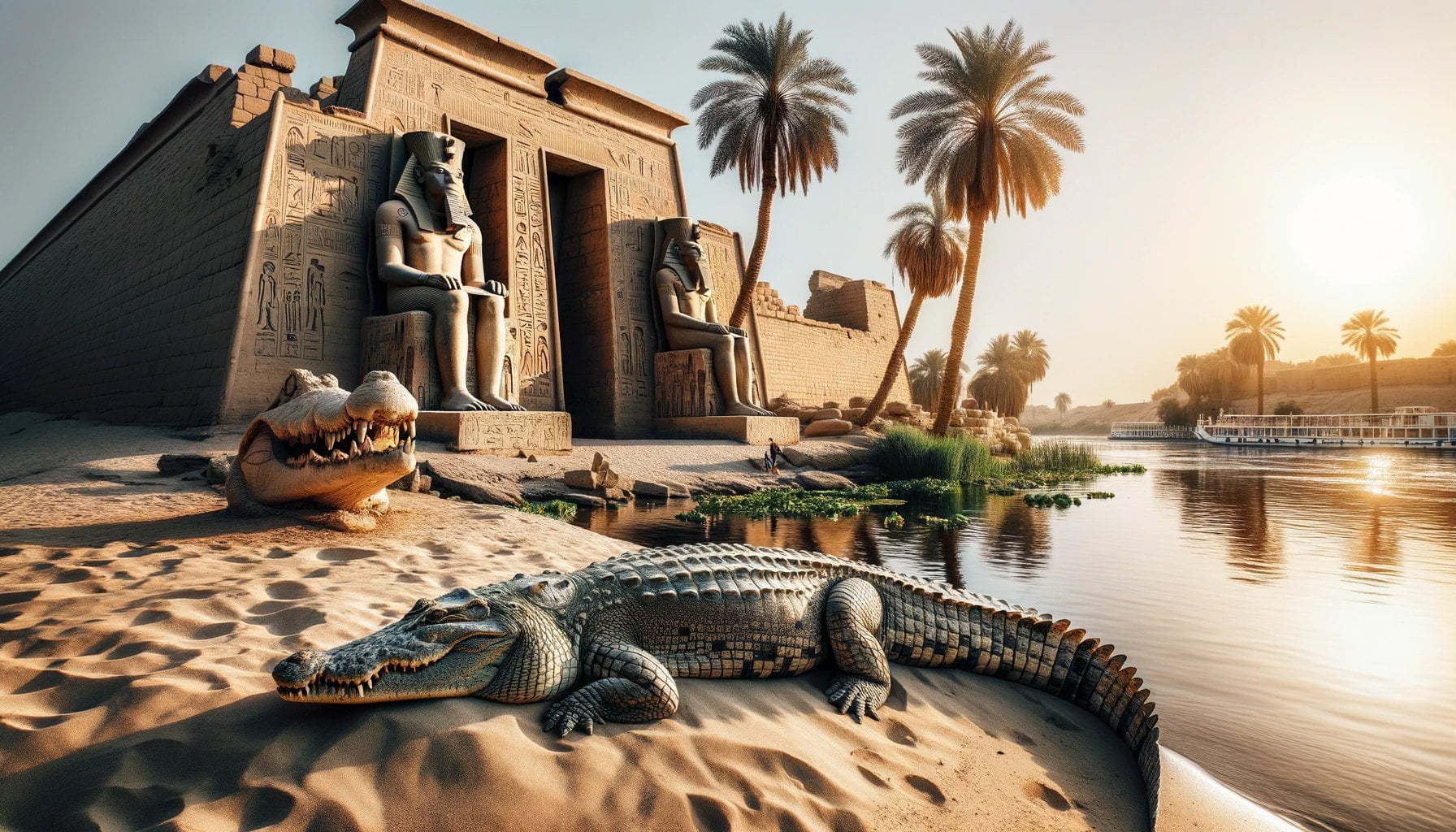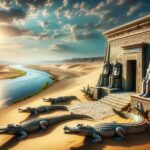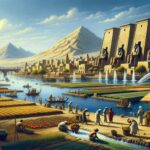Welcome to “Unveiling the Mysteries of the Crocodile God: Ancient Egypt’s Divine Creature,” where we embark on a captivating journey through the intricacies of ancient Egyptian culture and religion. In this enlightening exploration, we delve into the enigmatic world of the crocodile god, a fascinating figure deeply rooted in the ancient Egyptians’ beliefs and mythology. With extensive research and deep expertise in the field of archaeology, we unravel the significance of this awe-inspiring creature within the ancient Egyptian pantheon, shedding light on its sacred role and uncovering the secrets surrounding its worship and symbolism. Join us as we uncover the profound mysteries that lie beyond the realm of the crocodile god in ancient Egypt.
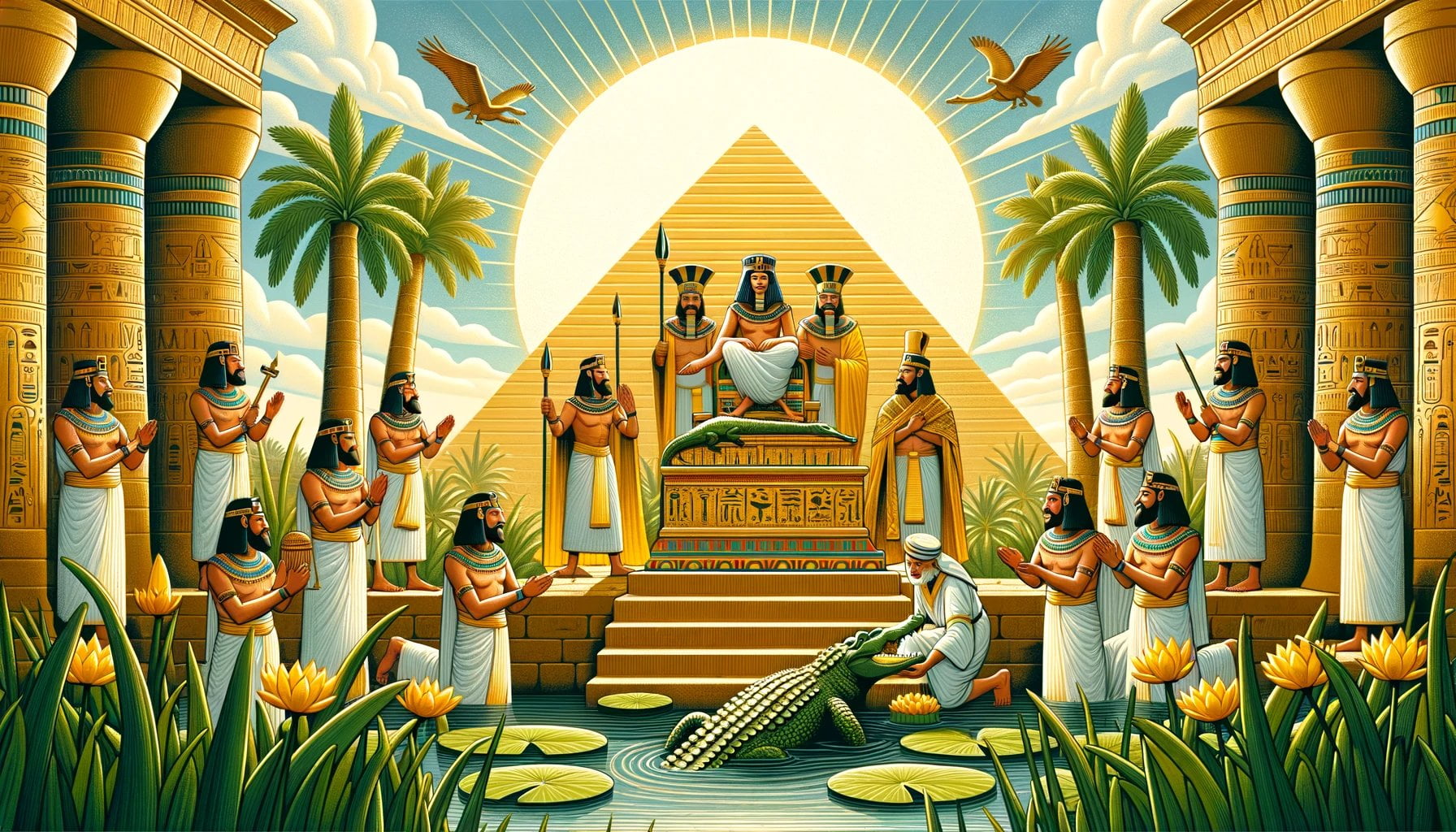
Key Takeaways:
- Sobek is an ancient Egyptian deity associated with the Nile crocodile or the West African crocodile.
- Sobek had a longstanding presence in the ancient Egyptian pantheon from the Old Kingdom through the Roman period.
- Sobek was often fused with the falcon-headed god Horus, which brought him closer to the kings of Egypt and gave him greater prominence in the pantheon.
- Sobek also acquired a role as a solar deity and was later fused with the primary sun god Ra, becoming Sobek-Ra.
- The Faiyum region served as a cult center of Sobek, with each town having its own localized version of the god.
- Sobek Shedety, the patron deity of Crocodilopolis (Shedet), was the most prominent form of Sobek.
- Building programs were initiated, possibly by Ptolemy II, to expand Sobek’s temple in Shedet.
- The Greco-Roman period provided numerous sources that relate to temples and priests of Sobek and his local incarnations.
Unveiling the Mysteries of the Crocodile God: Ancient Egypt’s Divine Creature
The ancient Egyptians held a deep reverence for the natural world, and their pantheon of gods and goddesses reflected this reverence. Among the intriguing deities of ancient Egypt, one that stands out is Sobek, the crocodile god. In this article, we will explore the significance of Sobek in ancient Egyptian culture, delving into the realms of mythology, religious rituals, and the worship of this awe-inspiring creature.
The Allure of Sobek
Sobek, often depicted with the ferocious head of a crocodile and the body of a human, captured the imaginations of the ancient Egyptians. Associated with the powerful Nile crocodile, Aswan region and the Faiyum, Sobek’s presence in the ancient Egyptian pantheon spanned centuries, from the Old Kingdom to the Roman period. The deity’s enduring popularity can be attributed to various factors, including his connection to the life-giving Nile, his association with creation and fertility, and his role as a guardian deity.
Sobek’s Origins and Evolution
In the Pyramid Texts of the Old Kingdom, Sobek made his first appearances, with spell PT 317 referencing this crocodile god. However, it was during the Middle Kingdom that Sobek gained prominence, especially under the reign of Pharaoh Amenemhat III, who held a particular interest in the Faiyum region, known for its association with Sobek.
To solidify his influence and power, Sobek became fused with the falcon-headed god Horus, linking him directly to the Egyptian pharaohs and elevating his status in the pantheon. Over time, Sobek acquired solar attributes and merged with the primary sun god Ra, forming the deity known as Sobek-Ra.
The Role of Sobek
As a deity associated with the Nile crocodile, Sobek embodied both protective and fearsome qualities. The ancient Egyptians believed that Sobek guarded the waters, ensuring that the Nile’s annual flood would bring fertility and abundance to the land. He was also seen as a protective god, safeguarding people from the dangers lurking in the Nile’s depths.
Moreover, Sobek played a crucial role in religious rituals, often being invoked to bless and purify individuals and temples. The Faiyum region, particularly Crocodilopolis (Shedet), served as a significant cult center dedicated to Sobek. Each town within the Faiyum had its own localized version of the god, but Sobek Shedety of Crocodilopolis stood out as the most prominent form.
Sobek in Greco-Roman Times
Even after the fall of Egypt’s native dynasty, the adoration of Sobek endured. Throughout the Greco-Roman period, numerous sources such as papyri, ostraca, and inscriptions shed light on the temples and priests devoted to Sobek and his various localized incarnations.
The devotion to Sobek extended to building programs, possibly initiated by Ptolemy II, aimed at expanding the temples dedicated to the crocodile god. These building efforts were a testament to Sobek’s continued importance in Egyptian religious practices, even in the face of political and cultural changes.
Unraveling the Mysteries
In our quest to understand the crocodile god of ancient Egypt, we have uncovered the captivating allure and multifaceted nature of Sobek. From his origins in the Old Kingdom to his fusion with Horus and Ra, Sobek’s presence underscored the significance of the Nile crocodile in Egyptian culture. Devoted worship and elaborate rituals at the prominent cult center of Crocodilopolis further emphasized the god’s importance.
Through the passages of time, Sobek continued to hold a place as one of the most intriguing deities in the ancient Egyptian pantheon. In unraveling the mysteries surrounding this divine creature, we gain insight into the religious beliefs of an extraordinary civilization that thrived along the banks of the Nile.
So, let us embark on this journey together, delving deeper into the fascinating world of the crocodile god ancient Egypt and unraveling the enigmatic tapestry of this awe-inspiring deity.
Ancient Egypt was a land filled with mystical wonders and fascinating beliefs. From the supreme god of ancient Egypt to the enchanting world of magic, there is so much to explore. Uncover the secrets of the supreme god of ancient Egypt and dive into the realm of the divine with our captivating article on the supreme god of ancient Egypt.
Embark on a journey through time and discover the ancient art of magic in Egypt. Unravel the mysteries of spells and rituals with our in-depth exploration of magic in ancient Egypt.
Delve into the ancient laws that governed everyday life in the land of the pharaohs. Unearth the ten laws of ancient Egypt and discover how they shaped society with our eye-opening article on the 10 laws of ancient Egypt.
In ancient Egypt, birds held a special place in the hearts of the people. Learn about the bird venerated in ancient Egypt and the significance it held in their culture by clicking on bird venerated in ancient Egypt.
Did you know that toothpaste has ancient origins? Find out how the Egyptians cared for their dental hygiene and the surprising ingredients they used in our intriguing article on toothpaste in ancient Egypt.
While ancient Egypt boasts incredible achievements, there were also some dark aspects to their society. Discover the less-known side of ancient Egypt and uncover the bad things about ancient Egypt that history books often overlook.
Cats hold a special place in ancient Egyptian history, but did you know that black cats were considered particularly auspicious? Learn more about the significance of black cats in ancient Egypt and their deep-rooted symbolism by clicking on black cat ancient Egypt.
Step into the world of ancient queens and immerse yourself in the lives of powerful female rulers. Uncover the untold stories of the ancient queens of Egypt and the influence they exerted in a male-dominated society.
The land of ancient Egypt is shrouded in mystery, with many secrets waiting to be unraveled. Journey through the enigmatic past and explore the intriguing mysteries of ancient Egypt that continue to bewilder historians and archaeologists.
Snakes played a significant role in ancient Egyptian culture and religion. Discover the importance of these slithering creatures and unravel the symbolism behind them in our captivating article on the snakes of ancient Egypt.
Embark on a voyage of discovery, click on the links, and delve into the enchanting world of ancient Egypt.
Role of Sobek in ancient Egyptian mythology
Sobek, the ancient Egyptian god of water, fertility, and military prowess, held a significant role in the religious beliefs and cultural practices of ancient Egyptians. As we uncover the mysteries surrounding this divine creature, we gain insight into the deep-rooted reverence for the natural world in ancient Egypt.
The Powerful Protector
Sobek: The Nile’s Guardian
Sobek, associated with the fearsome Nile crocodile, was esteemed as a formidable deity who safeguarded the ancient Egyptians. The Nile played a vital role in sustaining life, and Sobek’s role as its guardian made him a symbol of protection and prosperity. With his immense strength and power, Sobek ensured the fertility of the land, crops, cattle, and people.
Worship and Rituals
An Integral Part of Egyptian Culture
The worship of Sobek occupied a significant place in ancient Egyptian culture, with his priests presiding over various rituals and practices. Temples dedicated to Sobek, especially in the Faiyum region, were focal points of his worship. In these temples, priests engaged in mummifying crocodiles and managed the sacred grounds.
Rich Symbolism and Mythology
Unleashing Ancient Tales
Sobek’s striking appearance, often depicted with a crocodile head, further emphasized his connection to this awe-inspiring creature. In Egyptian mythology, Sobek played a role in assisting the birth of the falcon-headed god Horus and aiding in the defeat of the malevolent deity Seth.
Enduring Worship
From the Old Kingdom to the Greco-Roman Period
Sobek’s role as a deity persisted throughout different epochs, from the Old Kingdom to the Roman period. Even after the fall of Egypt’s native dynasty, the worship of Sobek carried on during the Greco-Roman era. This enduring devotion is evident through the expansion of temples dedicated to Sobek, affirming his continued importance in Egyptian religious practices.
Key Takeaways:
- Sobek, the mighty crocodile god, served as the protector of the Nile and ensured fertility and prosperity for the land, crops, cattle, and people.
- The worship of Sobek was deeply ingrained in ancient Egyptian culture, with priests overseeing rituals and practices in dedicated temples.
- Sobek’s connection to crocodiles and his portrayal as a powerful deity with a crocodile head contributed to his rich symbolism and mythology.
- The worship of Sobek endured from the Old Kingdom until the Greco-Roman period, with temples dedicated to him witnessing expansion and continued religious significance.
Sources:
– Sobek The Egyptian God: Curious Facts
– The God: Sobek – Egyptian Witchcraft
Religious rituals and worship associated with Sobek
It is fascinating to delve into the religious rituals and worship associated with Sobek, the crocodile god of ancient Egypt. His significance in Egyptian culture cannot be overstated, as he represented power, virility, and fertility. Let’s explore some key aspects of the religious practices surrounding this awe-inspiring creature.
The Sacred Crocodile:
In the city of Faiyum, located in the Nile Delta region, lay the chief sanctuary dedicated to Sobek. Within this sanctuary resided a live sacred crocodile named Petsuchos. The presence of this crocodile was of utmost importance, as it symbolized the deity’s presence and was considered a direct link between Sobek and the devotees [^5^]. Crocodiles were also bred, raised, and mummified in the Faiyum region, indicating the deep reverence and association they had with Sobek [^7^].
Worship and Religious Practices:
The worship of Sobek was an integral part of the ancient Egyptian religious landscape. Devotees sought the blessings and protection of this powerful deity through various rituals and offerings. Priests played a significant role in carrying out these religious practices within the sanctuaries dedicated to Sobek [^6^]. They conducted ceremonies and maintained the sacred spaces where worship and communication with the divine took place.
Blessings and Purification:
One of the important roles played by Sobek in religious rituals was that of a bestower of blessings and purifier. People sought his favor and protection, particularly during important life events or in the presence of impurities. Sobek’s presence ensured the sanctity of places of worship and the purity of individuals who sought his divine intercession [^6^].
Symbolism and Stories:
Ancient Egyptian mythology is rich with stories and symbolism associated with Sobek. He was often depicted as the messenger of Set, the Egyptian god of chaos. This connection highlights Sobek’s role as a powerful being entrusted with maintaining cosmic balance. Additionally, Sobek was believed to have assisted in the birth of the god Horus and played a key role in defeating the deity Seth, further emphasizing his significance in ancient Egyptian narratives [^6^].
The Importance of Sobek:
Sobek occupied a significant place in ancient Egyptian society, not just in religious contexts, but also as the patron of the Egyptian army. He was considered a defender of the pharaoh and a personification of strength and power. The worship of Sobek continued throughout different periods, from the Old Kingdom to the Roman period. Temples dedicated to Sobek expanded and played a central role in religious practices, showcasing the enduring importance of this crocodile god in ancient Egyptian culture [^8^].
Key Takeaways:
– Sobek, the crocodile god of ancient Egypt, was worshipped since the Old Kingdom and was associated with power and protection [^2^].
– His worship included elaborate rituals conducted by priests in dedicated sanctuaries, with live sacred crocodiles playing a central role [^5^].
– Sobek’s blessings and purification rituals were sought by devotees, ensuring the sanctity of places of worship and the purity of individuals [^6^].
– Symbolically, Sobek represented cosmic balance and played a significant role in ancient Egyptian mythology [^6^].
– Sobek’s role as a defender of the pharaoh and patron of the Egyptian army showcased his association with strength and power [^8^].
Sources:
– Anthropology Review. [ancient]. Available at: https://anthropologyreview.org/history/ancient.
– Old World Gods. [crocodile-god-sobek]. Available at: https://oldworldgods.com/egyptians/crocodile-god-sobek.
Symbolism and Significance of Sobek in Ancient Egyptian Culture
Sobek, the crocodile-headed god, held immense symbolism and significance in ancient Egyptian culture. Worshiped throughout Egypt, Sobek represented power, virility, and fertility, while also embodying the duality of nature. As a protector of the pharaoh and the people, Sobek played a vital role in maintaining order and overcoming obstacles. The worship of Sobek involved intricate rituals and sacrifices, showcasing the deep reverence the ancient Egyptians held for this awe-inspiring creature.
Discovery and Worship of Sobek
Sobek’s worship dates back to the Old Kingdom in ancient Egypt. He was depicted as a man with the head of a crocodile, symbolizing his association with these powerful creatures. The Nile, the life-giving force of Egypt, played a crucial role in the cultural significance of Sobek. With temples dedicated to him across the land, Sobek was revered as a protector and guide.
The Symbolism of Sobek
The primary symbol associated with Sobek was the crocodile, which held deep symbolism in ancient Egyptian culture. The crocodile represented fertility, pharaonic power, military prowess, and protection. Sobek, being a hybrid creature, embodied the connection between the natural and supernatural worlds. This multifaceted symbolism showcased his importance within the Egyptian pantheon.
Sobek as a Protective Deity
Sobek played a vital role in protecting the pharaoh, the Egyptian army, and the people. His strength and courage enabled the pharaoh to overcome obstacles and protected him from evil magic. Considered a defender of cosmic balance, Sobek maintained order in the world, ensuring harmony and stability.
Worship and Rituals
The worship of Sobek involved elaborate rituals and ceremonies conducted at various temple sites across Egypt. Sacrifices were made to honor Sobek and seek his protection and favor. The people of ancient Egypt held crocodiles in great honor, viewing them as sacred creatures associated with Sobek and the fertility of the land.
The Legacy of Sobek
While ancient Egyptian worship of Sobek has diminished over time, his legacy continues to captivate modern audiences. Scholars, enthusiasts, and anyone seeking to understand the ancient Egyptian civilization on a deeper level are fascinated by Sobek’s representation and significance. Exploring the mysteries of Sobek provides valuable insights into the religious beliefs and cultural practices of ancient Egypt.
Key Takeaways:
– Sobek, the crocodile-headed god, held immense symbolism and significance in ancient Egyptian culture.
– Sobek symbolized power, virility, and fertility while representing the duality of nature.
– His worship involved intricate rituals and sacrifices conducted at various temple sites.
– The crocodile was the primary symbol associated with Sobek, representing fertility, pharaonic power, military prowess, and protection.
– Sobek played a vital role in protecting the pharaoh, the Egyptian army, and the people, maintaining order and overcoming obstacles.
– While ancient Egyptian worship of Sobek has diminished, his legacy continues to intrigue and captivate modern audiences.
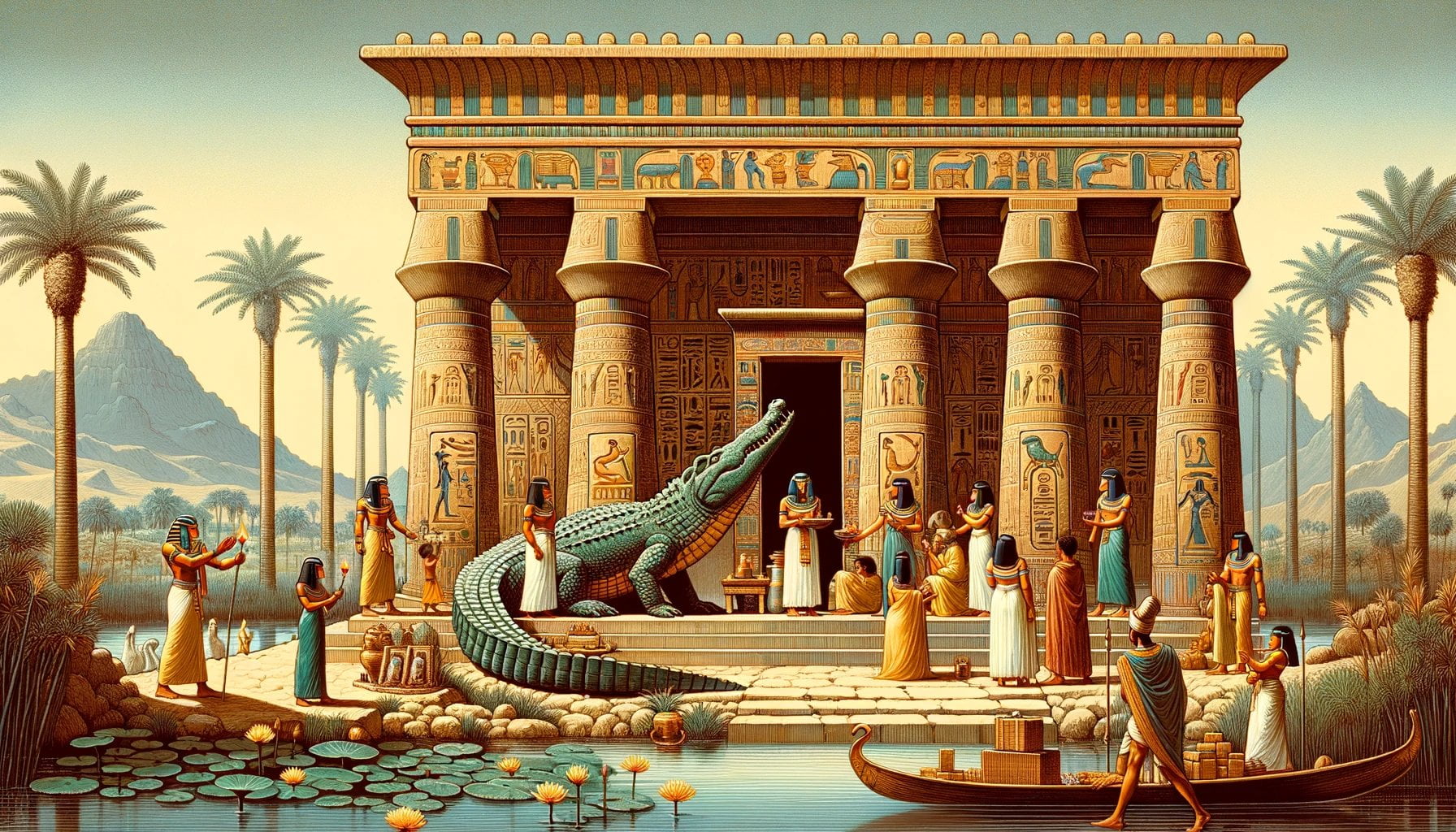
FAQ
Q1: What is the significance of Sobek in ancient Egyptian mythology?
A1: Sobek held significant importance in ancient Egyptian mythology as a symbol of power, virility, and fertility. He played a protective role, ensuring the prosperity of the pharaoh, the Egyptian army, and the people.
Q2: How was Sobek worshiped in ancient Egypt?
A2: The worship of Sobek involved elaborate rituals and ceremonies conducted at various temple sites across Egypt. Sacrifices were made to honor Sobek and seek his protection and favor. The people of ancient Egypt also held crocodiles in great honor and offered their devotion to ensure the fertility of the land.
Q3: What was the symbolism of Sobek in ancient Egyptian culture?
A3: Sobek’s primary symbol was the crocodile, which represented fertility, pharaonic power, military power and prowess, as well as protection. As a hybrid creature, Sobek epitomized the duality of nature and reflected the intersection of the natural and supernatural worlds.
Q4: What was Sobek’s role in the ancient Egyptian pantheon?
A4: Sobek played a crucial role in protecting the pharaoh, the Egyptian army, and the ancient Egyptian people. His strength and courage enabled the pharaoh to overcome obstacles and protected him from evil magic. Sobek was also believed to control the forces of chaos and maintain order in the world.
Q5: What is the modern legacy of Sobek?
A5: While ancient Egyptian worship of Sobek has diminished, his legacy still resonates. Sobek continues to captivate scholars, enthusiasts, and anyone seeking to understand the ancient Egyptian civilization on a deeper level. His representation in art and literature continues to intrigue and fascinate modern audiences.
- Crypto Quotes’ Red Flags: Avoid Costly Mistakes - June 30, 2025
- Unlock Inspirational Crypto Quotes: Future Predictions - June 30, 2025
- Famous Bitcoin Quotes: A Deep Dive into Crypto’s History - June 30, 2025
